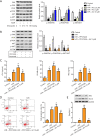Artesunate alleviates myocardial ischemia/reperfusion-induced myocardial necrosis in rats and hypoxia/reoxygenation-induced apoptosis in H9C2 cells via regulating the FAK/PI3K/Akt pathway
- PMID: 33209871
- PMCID: PMC7661874
- DOI: 10.21037/atm-20-5182
Artesunate alleviates myocardial ischemia/reperfusion-induced myocardial necrosis in rats and hypoxia/reoxygenation-induced apoptosis in H9C2 cells via regulating the FAK/PI3K/Akt pathway
Abstract
Background: The various anti-inflammatory, anti-apoptotic, and antioxidant effects of Artesunate (Art) have been explored in numerous studies. This study aimed to evaluate the function of Art on myocardial necrosis in apoptotic cardiomyocytes in vivo and in vitro.
Methods: Sprague Dawley (SD) rats were randomly divided into groups: a control group, a myocardial ischemia reperfusion (MI/R) group, and MI/R+ Art groups. To establish a MI/R model, rats were subjected to left anterior descending artery ischemia for 45 minutes, and then reperfusion for 2 hours. Hypoxia was induced in H9C2 cells by subjecting them to hypoxic conditions at 37 °C for 4 hours, before placing them in a normoxic chamber for 2 hours. The test methods were used in this test, such as echocardiography, enzyme-linked immunosorbent assay (ELISA), HE staining, TUNEL staining, immunohistochemistry, flow cytometry, western blot, and CCK-8 assay.
Results: Art improved myocardial systolic function caused by MI/R injury in vivo. Simultaneously, Art reduced the levels of cardiac troponin I (cTnl), creatine kinase-MB (CK-MB) and myohemoglobin (Mb) in vivo and in vitro. Moreover, Art inhibited cardiomyocyte apoptosis in vivo and in vitro. The focal adhesion kinase (FAK)/phosphatidylinositide-3 kinases (PI3K)/AKT signaling pathway was also activated by Art in vivo and in vitro. Furthermore, after inhibitor PF573228 was added, Art inhibited apoptosis in H9C2 cells via activation of the FAK/PI3K/AKT signaling pathway in vitro.
Conclusions: This study confirms that Art alleviated MI/R injury and inhibited cardiomyocyte apoptosis in vivo and in vitro. Art exerted an inhibitory effect on cardiomyocyte apoptosis by activating the FAK/PI3K/AKT signaling pathway. Therefore, Art may serve as an alternative treatment for MI/R injury.
Keywords: Artesunate; apoptosis; focal adhesion kinase/phosphatidylinositide-3 kinases/Akt pathway (FAK/PI3K/Akt pathway); hypoxia/reoxygenation; myocardial ischemia/reperfusion.
2020 Annals of Translational Medicine. All rights reserved.
Conflict of interest statement
Conflicts of Interest: All authors have completed the ICMJE uniform disclosure form (available at http://dx.doi.org/10.21037/atm-20-5182). The authors have no conflicts of interest to declare.
Figures





Similar articles
-
Asiaticoside alleviates cardiomyocyte apoptosis and oxidative stress in myocardial ischemia/reperfusion injury via activating the PI3K-AKT-GSK3β pathway in vivo and in vitro.Ann Transl Med. 2022 Jan;10(2):69. doi: 10.21037/atm-21-6667. Ann Transl Med. 2022. PMID: 35282120 Free PMC article.
-
Hypoxic preconditioning protects cardiomyocytes against hypoxia/reoxygenation-induced cell apoptosis via sphingosine kinase 2 and FAK/AKT pathway.Exp Mol Pathol. 2016 Feb;100(1):51-8. doi: 10.1016/j.yexmp.2015.11.025. Epub 2015 Nov 24. Exp Mol Pathol. 2016. PMID: 26621495
-
Ginsenoside Rg1 induces ferroptosis by regulating the focal adhesion kinase/protein kinase B-forkhead box O3A signaling pathway and alleviates sepsis-induced myocardial damage.J Physiol Pharmacol. 2024 Aug;75(4). doi: 10.26402/jpp.2024.4.04. Epub 2024 Oct 10. J Physiol Pharmacol. 2024. PMID: 39415524
-
Cardioprotective effect of breviscapine: inhibition of apoptosis in H9c2 cardiomyocytes via the PI3K/Akt/eNOS pathway following simulated ischemia/reperfusion injury.Pharmazie. 2015 Sep;70(9):593-7. Pharmazie. 2015. PMID: 26492644
-
Trimetazidine protects against myocardial ischemia/reperfusion injury by inhibiting excessive autophagy.J Mol Med (Berl). 2018 Aug;96(8):791-806. doi: 10.1007/s00109-018-1664-3. Epub 2018 Jun 29. J Mol Med (Berl). 2018. PMID: 29955901
Cited by
-
Carpaine Promotes Proliferation and Repair of H9c2 Cardiomyocytes after Oxidative Insults.Pharmaceuticals (Basel). 2022 Feb 15;15(2):230. doi: 10.3390/ph15020230. Pharmaceuticals (Basel). 2022. PMID: 35215343 Free PMC article.
-
Research advances on molecular mechanism and natural product therapy of iron metabolism in heart failure.Eur J Med Res. 2024 Apr 24;29(1):253. doi: 10.1186/s40001-024-01809-4. Eur J Med Res. 2024. PMID: 38659000 Free PMC article. Review.
References
LinkOut - more resources
Full Text Sources
Research Materials
Miscellaneous
